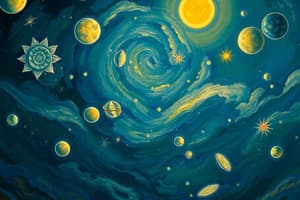Podcast
Questions and Answers
Which of the following planets is known to have a solid surface?
Which of the following planets is known to have a solid surface?
- Earth (correct)
- Saturn
- Jupiter
- Neptune
Which planet is considered the largest in our solar system?
Which planet is considered the largest in our solar system?
- Saturn
- Neptune
- Jupiter (correct)
- Uranus
Which planet is situated directly between Earth and Mars in the solar system?
Which planet is situated directly between Earth and Mars in the solar system?
- Jupiter
- Mercury
- Venus (correct)
- Saturn
What is the order of the first four planets from the Sun?
What is the order of the first four planets from the Sun?
What is the eighth and most distant planet in our solar system?
What is the eighth and most distant planet in our solar system?
What is the smallest planet of our solar system?
What is the smallest planet of our solar system?
How many times did you go star gazing?
How many times did you go star gazing?
Flashcards are hidden until you start studying
Study Notes
Overview of the Solar System
- The solar system consists of eight planets: Mercury, Venus, Earth, Mars, Jupiter, Saturn, Uranus, and Neptune.
- There are five officially recognized dwarf planets: Ceres, Pluto, Haumea, Makemake, and Eris.
Inner Planets (Terrestrial)
- Inner planets are Mercury, Venus, Earth, and Mars; they are termed terrestrial due to their solid surfaces.
- Mercury:
- Smallest planet and closest to the Sun.
- Venus:
- Second planet from the Sun and Earth's nearest neighbor.
- Earth:
- Third planet from the Sun and the fifth largest.
- Mars:
- Fourth planet, characterized as a dusty, cold desert world with a thin atmosphere.
Outer Planets (Gas and Ice Giants)
- Outer planets do not have hard surfaces and consist mainly of gases or ices.
- Jupiter:
- Largest planet in the solar system; could fit 1,000 Earths within its volume.
- Saturn:
- Sixth planet and the second largest in the solar system.
- Uranus:
- Seventh planet with the third largest diameter among all planets.
- Neptune:
- Eighth and most distant planet.
Dwarf Planets
- Dwarf planets are smaller celestial bodies beyond Neptune.
- Ceres:
- Largest object in the asteroid belt between Mars and Jupiter and the only dwarf planet in the inner solar system.
- Pluto:
- Formerly classified as the ninth planet, reclassified as a dwarf planet in 2006.
- Haumea:
- Notable for its oval shape and rapid rotation; nicknamed Santa.
- Makemake:
- Slightly smaller than Pluto and the second-brightest Kuiper Belt object after Pluto.
- Eris:
- Its discovery prompted re-evaluation of the planet definition criteria.
Summary of Key Facts
- The solar system contains eight main planets and five dwarf planets.
- Mercury is the smallest planet, while Jupiter is the largest.
- Dwarf planet Ceres is located in the main asteroid belt.
- Pluto's status change sparked significant discussion regarding planet classifications.
Studying That Suits You
Use AI to generate personalized quizzes and flashcards to suit your learning preferences.





